TAFE NSW CHCPRP003 Reflect on and Improve Own Professional Practice
VerifiedAdded on 2023/06/03
|31
|7161
|71
Homework Assignment
AI Summary
This document provides a detailed response to the CHCPRP003 Reflect on and Improve Own Professional Practice Theory Assessment Task. The assessment covers key aspects of reflective practice, including its definition, benefits for early childhood professionals, and the stages of the reflective process cycle. It explores ethical values and processes applied by educators, with examples and justifications. The assignment also addresses feedback, defining it and analyzing different types of responses to feedback, providing reasons for each. The provided answers draw on the required readings, including the Victorian Early Years Learning and Development Framework and articles on giving and receiving feedback.
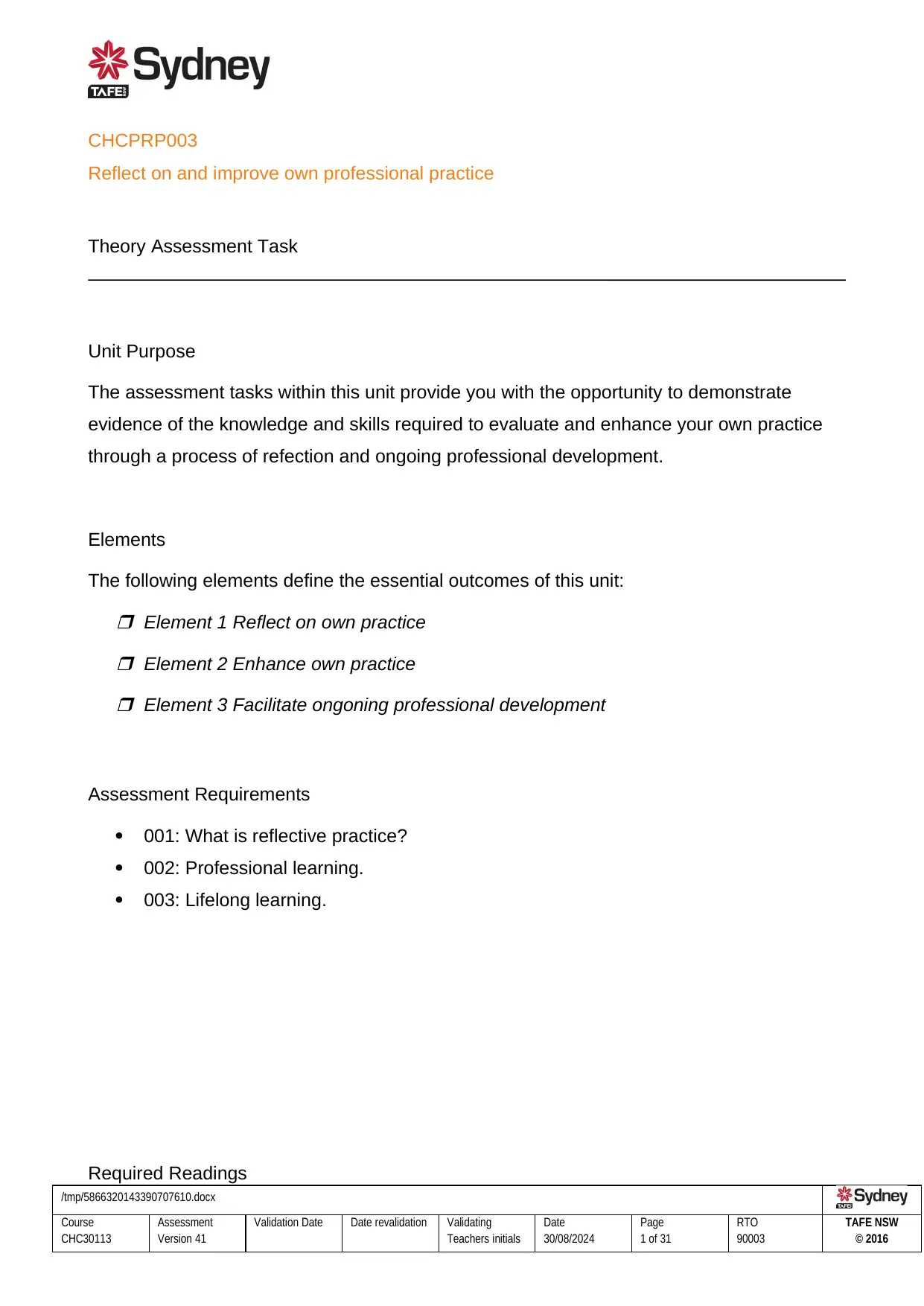
CHCPRP003
Reflect on and improve own professional practice
Theory Assessment Task
Unit Purpose
The assessment tasks within this unit provide you with the opportunity to demonstrate
evidence of the knowledge and skills required to evaluate and enhance your own practice
through a process of refection and ongoing professional development.
Elements
The following elements define the essential outcomes of this unit:
Element 1 Reflect on own practice
Element 2 Enhance own practice
Element 3 Facilitate ongoning professional development
Assessment Requirements
001: What is reflective practice?
002: Professional learning.
003: Lifelong learning.
Required Readings
/tmp/5866320143390707610.docx
Course
CHC30113
Assessment
Version 41
Validation Date Date revalidation Validating
Teachers initials
Date
30/08/2024
Page
1 of 31
RTO
90003
TAFE NSW
© 2016
Reflect on and improve own professional practice
Theory Assessment Task
Unit Purpose
The assessment tasks within this unit provide you with the opportunity to demonstrate
evidence of the knowledge and skills required to evaluate and enhance your own practice
through a process of refection and ongoing professional development.
Elements
The following elements define the essential outcomes of this unit:
Element 1 Reflect on own practice
Element 2 Enhance own practice
Element 3 Facilitate ongoning professional development
Assessment Requirements
001: What is reflective practice?
002: Professional learning.
003: Lifelong learning.
Required Readings
/tmp/5866320143390707610.docx
Course
CHC30113
Assessment
Version 41
Validation Date Date revalidation Validating
Teachers initials
Date
30/08/2024
Page
1 of 31
RTO
90003
TAFE NSW
© 2016
Paraphrase This Document
Need a fresh take? Get an instant paraphrase of this document with our AI Paraphraser
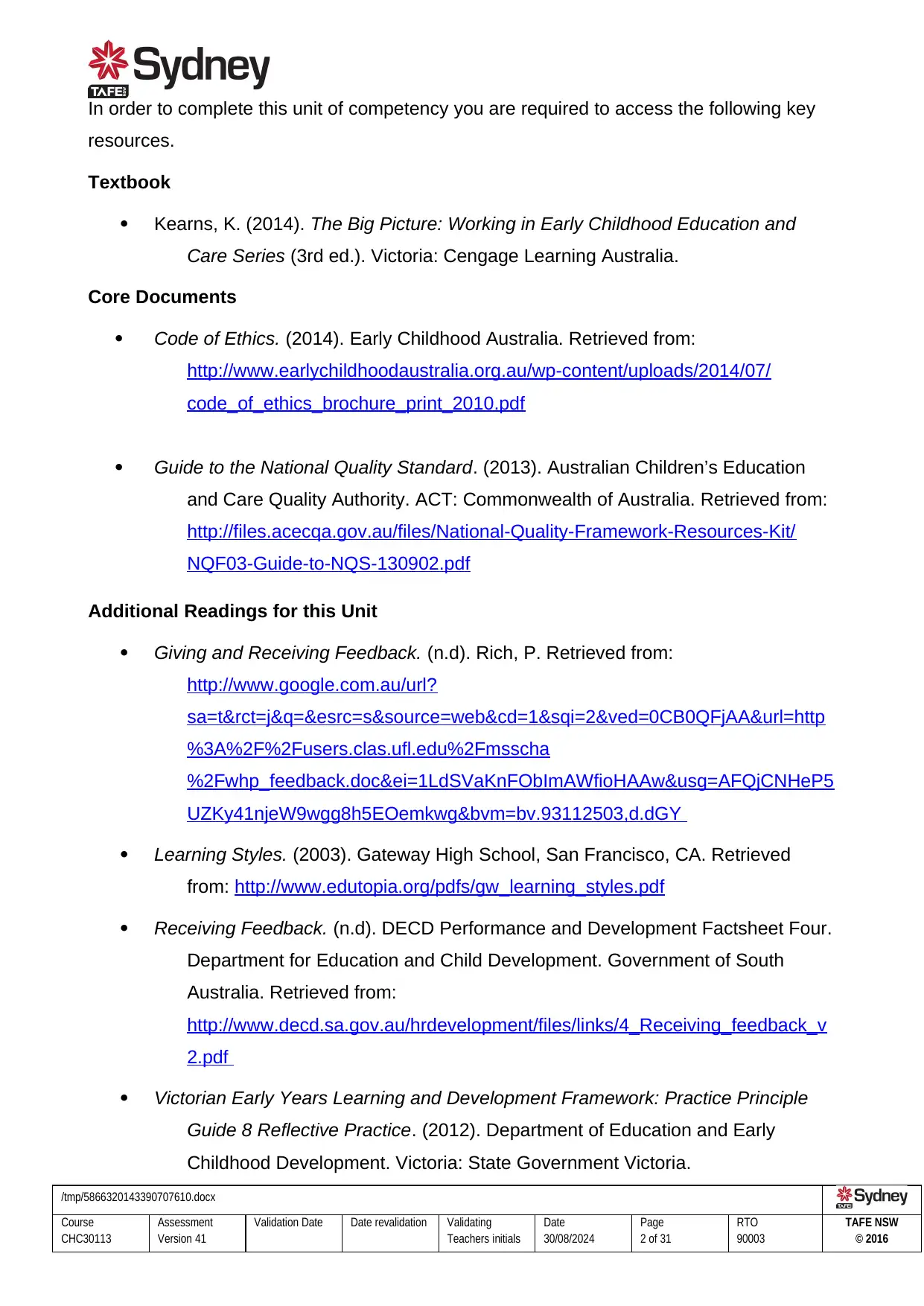
In order to complete this unit of competency you are required to access the following key
resources.
Textbook
Kearns, K. (2014). The Big Picture: Working in Early Childhood Education and
Care Series (3rd ed.). Victoria: Cengage Learning Australia.
Core Documents
Code of Ethics. (2014). Early Childhood Australia. Retrieved from:
http://www.earlychildhoodaustralia.org.au/wp-content/uploads/2014/07/
code_of_ethics_brochure_print_2010.pdf
Guide to the National Quality Standard. (2013). Australian Children’s Education
and Care Quality Authority. ACT: Commonwealth of Australia. Retrieved from:
http://files.acecqa.gov.au/files/National-Quality-Framework-Resources-Kit/
NQF03-Guide-to-NQS-130902.pdf
Additional Readings for this Unit
Giving and Receiving Feedback. (n.d). Rich, P. Retrieved from:
http://www.google.com.au/url?
sa=t&rct=j&q=&esrc=s&source=web&cd=1&sqi=2&ved=0CB0QFjAA&url=http
%3A%2F%2Fusers.clas.ufl.edu%2Fmsscha
%2Fwhp_feedback.doc&ei=1LdSVaKnFObImAWfioHAAw&usg=AFQjCNHeP5
UZKy41njeW9wgg8h5EOemkwg&bvm=bv.93112503,d.dGY
Learning Styles. (2003). Gateway High School, San Francisco, CA. Retrieved
from: http://www.edutopia.org/pdfs/gw_learning_styles.pdf
Receiving Feedback. (n.d). DECD Performance and Development Factsheet Four.
Department for Education and Child Development. Government of South
Australia. Retrieved from:
http://www.decd.sa.gov.au/hrdevelopment/files/links/4_Receiving_feedback_v
2.pdf
Victorian Early Years Learning and Development Framework: Practice Principle
Guide 8 Reflective Practice. (2012). Department of Education and Early
Childhood Development. Victoria: State Government Victoria.
/tmp/5866320143390707610.docx
Course
CHC30113
Assessment
Version 41
Validation Date Date revalidation Validating
Teachers initials
Date
30/08/2024
Page
2 of 31
RTO
90003
TAFE NSW
© 2016
resources.
Textbook
Kearns, K. (2014). The Big Picture: Working in Early Childhood Education and
Care Series (3rd ed.). Victoria: Cengage Learning Australia.
Core Documents
Code of Ethics. (2014). Early Childhood Australia. Retrieved from:
http://www.earlychildhoodaustralia.org.au/wp-content/uploads/2014/07/
code_of_ethics_brochure_print_2010.pdf
Guide to the National Quality Standard. (2013). Australian Children’s Education
and Care Quality Authority. ACT: Commonwealth of Australia. Retrieved from:
http://files.acecqa.gov.au/files/National-Quality-Framework-Resources-Kit/
NQF03-Guide-to-NQS-130902.pdf
Additional Readings for this Unit
Giving and Receiving Feedback. (n.d). Rich, P. Retrieved from:
http://www.google.com.au/url?
sa=t&rct=j&q=&esrc=s&source=web&cd=1&sqi=2&ved=0CB0QFjAA&url=http
%3A%2F%2Fusers.clas.ufl.edu%2Fmsscha
%2Fwhp_feedback.doc&ei=1LdSVaKnFObImAWfioHAAw&usg=AFQjCNHeP5
UZKy41njeW9wgg8h5EOemkwg&bvm=bv.93112503,d.dGY
Learning Styles. (2003). Gateway High School, San Francisco, CA. Retrieved
from: http://www.edutopia.org/pdfs/gw_learning_styles.pdf
Receiving Feedback. (n.d). DECD Performance and Development Factsheet Four.
Department for Education and Child Development. Government of South
Australia. Retrieved from:
http://www.decd.sa.gov.au/hrdevelopment/files/links/4_Receiving_feedback_v
2.pdf
Victorian Early Years Learning and Development Framework: Practice Principle
Guide 8 Reflective Practice. (2012). Department of Education and Early
Childhood Development. Victoria: State Government Victoria.
/tmp/5866320143390707610.docx
Course
CHC30113
Assessment
Version 41
Validation Date Date revalidation Validating
Teachers initials
Date
30/08/2024
Page
2 of 31
RTO
90003
TAFE NSW
© 2016
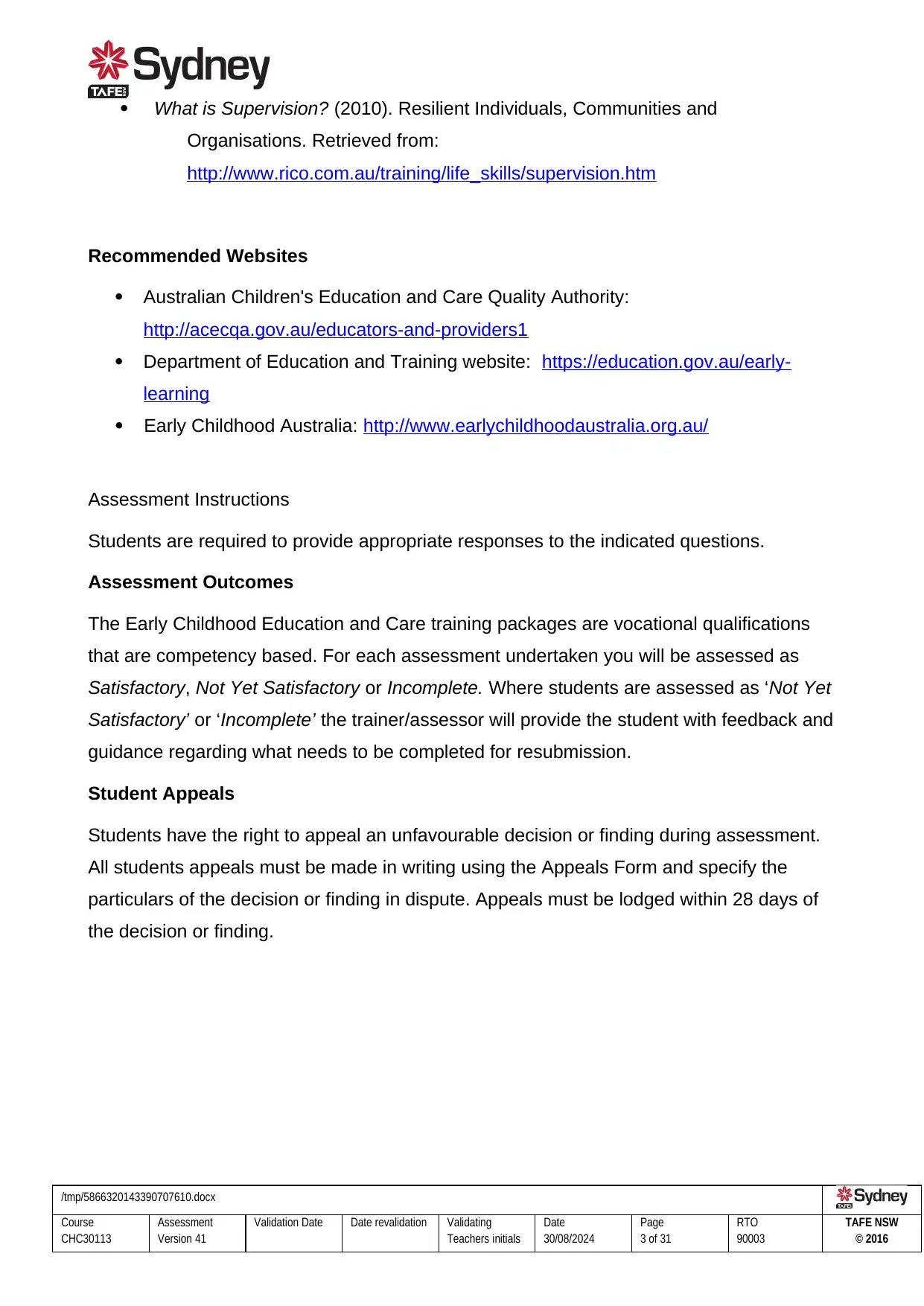
What is Supervision? (2010). Resilient Individuals, Communities and
Organisations. Retrieved from:
http://www.rico.com.au/training/life_skills/supervision.htm
Recommended Websites
Australian Children's Education and Care Quality Authority:
http://acecqa.gov.au/educators-and-providers1
Department of Education and Training website: https://education.gov.au/early-
learning
Early Childhood Australia: http://www.earlychildhoodaustralia.org.au/
Assessment Instructions
Students are required to provide appropriate responses to the indicated questions.
Assessment Outcomes
The Early Childhood Education and Care training packages are vocational qualifications
that are competency based. For each assessment undertaken you will be assessed as
Satisfactory, Not Yet Satisfactory or Incomplete. Where students are assessed as ‘Not Yet
Satisfactory’ or ‘Incomplete’ the trainer/assessor will provide the student with feedback and
guidance regarding what needs to be completed for resubmission.
Student Appeals
Students have the right to appeal an unfavourable decision or finding during assessment.
All students appeals must be made in writing using the Appeals Form and specify the
particulars of the decision or finding in dispute. Appeals must be lodged within 28 days of
the decision or finding.
/tmp/5866320143390707610.docx
Course
CHC30113
Assessment
Version 41
Validation Date Date revalidation Validating
Teachers initials
Date
30/08/2024
Page
3 of 31
RTO
90003
TAFE NSW
© 2016
Organisations. Retrieved from:
http://www.rico.com.au/training/life_skills/supervision.htm
Recommended Websites
Australian Children's Education and Care Quality Authority:
http://acecqa.gov.au/educators-and-providers1
Department of Education and Training website: https://education.gov.au/early-
learning
Early Childhood Australia: http://www.earlychildhoodaustralia.org.au/
Assessment Instructions
Students are required to provide appropriate responses to the indicated questions.
Assessment Outcomes
The Early Childhood Education and Care training packages are vocational qualifications
that are competency based. For each assessment undertaken you will be assessed as
Satisfactory, Not Yet Satisfactory or Incomplete. Where students are assessed as ‘Not Yet
Satisfactory’ or ‘Incomplete’ the trainer/assessor will provide the student with feedback and
guidance regarding what needs to be completed for resubmission.
Student Appeals
Students have the right to appeal an unfavourable decision or finding during assessment.
All students appeals must be made in writing using the Appeals Form and specify the
particulars of the decision or finding in dispute. Appeals must be lodged within 28 days of
the decision or finding.
/tmp/5866320143390707610.docx
Course
CHC30113
Assessment
Version 41
Validation Date Date revalidation Validating
Teachers initials
Date
30/08/2024
Page
3 of 31
RTO
90003
TAFE NSW
© 2016
⊘ This is a preview!⊘
Do you want full access?
Subscribe today to unlock all pages.

Trusted by 1+ million students worldwide
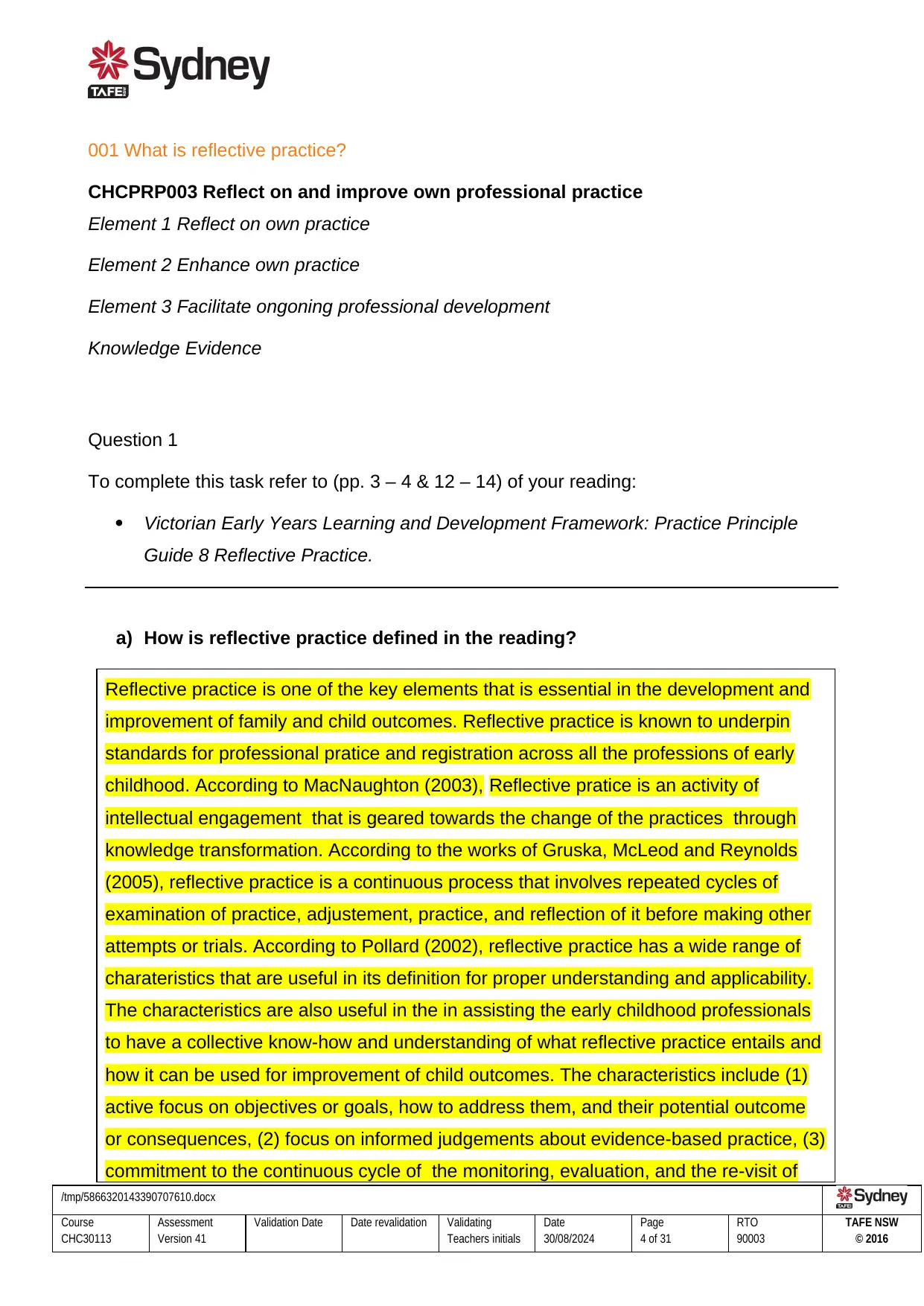
001 What is reflective practice?
CHCPRP003 Reflect on and improve own professional practice
Element 1 Reflect on own practice
Element 2 Enhance own practice
Element 3 Facilitate ongoning professional development
Knowledge Evidence
Question 1
To complete this task refer to (pp. 3 – 4 & 12 – 14) of your reading:
Victorian Early Years Learning and Development Framework: Practice Principle
Guide 8 Reflective Practice.
a) How is reflective practice defined in the reading?
Reflective practice is one of the key elements that is essential in the development and
improvement of family and child outcomes. Reflective practice is known to underpin
standards for professional pratice and registration across all the professions of early
childhood. According to MacNaughton (2003), Reflective pratice is an activity of
intellectual engagement that is geared towards the change of the practices through
knowledge transformation. According to the works of Gruska, McLeod and Reynolds
(2005), reflective practice is a continuous process that involves repeated cycles of
examination of practice, adjustement, practice, and reflection of it before making other
attempts or trials. According to Pollard (2002), reflective practice has a wide range of
charateristics that are useful in its definition for proper understanding and applicability.
The characteristics are also useful in the in assisting the early childhood professionals
to have a collective know-how and understanding of what reflective practice entails and
how it can be used for improvement of child outcomes. The characteristics include (1)
active focus on objectives or goals, how to address them, and their potential outcome
or consequences, (2) focus on informed judgements about evidence-based practice, (3)
commitment to the continuous cycle of the monitoring, evaluation, and the re-visit of
/tmp/5866320143390707610.docx
Course
CHC30113
Assessment
Version 41
Validation Date Date revalidation Validating
Teachers initials
Date
30/08/2024
Page
4 of 31
RTO
90003
TAFE NSW
© 2016
CHCPRP003 Reflect on and improve own professional practice
Element 1 Reflect on own practice
Element 2 Enhance own practice
Element 3 Facilitate ongoning professional development
Knowledge Evidence
Question 1
To complete this task refer to (pp. 3 – 4 & 12 – 14) of your reading:
Victorian Early Years Learning and Development Framework: Practice Principle
Guide 8 Reflective Practice.
a) How is reflective practice defined in the reading?
Reflective practice is one of the key elements that is essential in the development and
improvement of family and child outcomes. Reflective practice is known to underpin
standards for professional pratice and registration across all the professions of early
childhood. According to MacNaughton (2003), Reflective pratice is an activity of
intellectual engagement that is geared towards the change of the practices through
knowledge transformation. According to the works of Gruska, McLeod and Reynolds
(2005), reflective practice is a continuous process that involves repeated cycles of
examination of practice, adjustement, practice, and reflection of it before making other
attempts or trials. According to Pollard (2002), reflective practice has a wide range of
charateristics that are useful in its definition for proper understanding and applicability.
The characteristics are also useful in the in assisting the early childhood professionals
to have a collective know-how and understanding of what reflective practice entails and
how it can be used for improvement of child outcomes. The characteristics include (1)
active focus on objectives or goals, how to address them, and their potential outcome
or consequences, (2) focus on informed judgements about evidence-based practice, (3)
commitment to the continuous cycle of the monitoring, evaluation, and the re-visit of
/tmp/5866320143390707610.docx
Course
CHC30113
Assessment
Version 41
Validation Date Date revalidation Validating
Teachers initials
Date
30/08/2024
Page
4 of 31
RTO
90003
TAFE NSW
© 2016
Paraphrase This Document
Need a fresh take? Get an instant paraphrase of this document with our AI Paraphraser
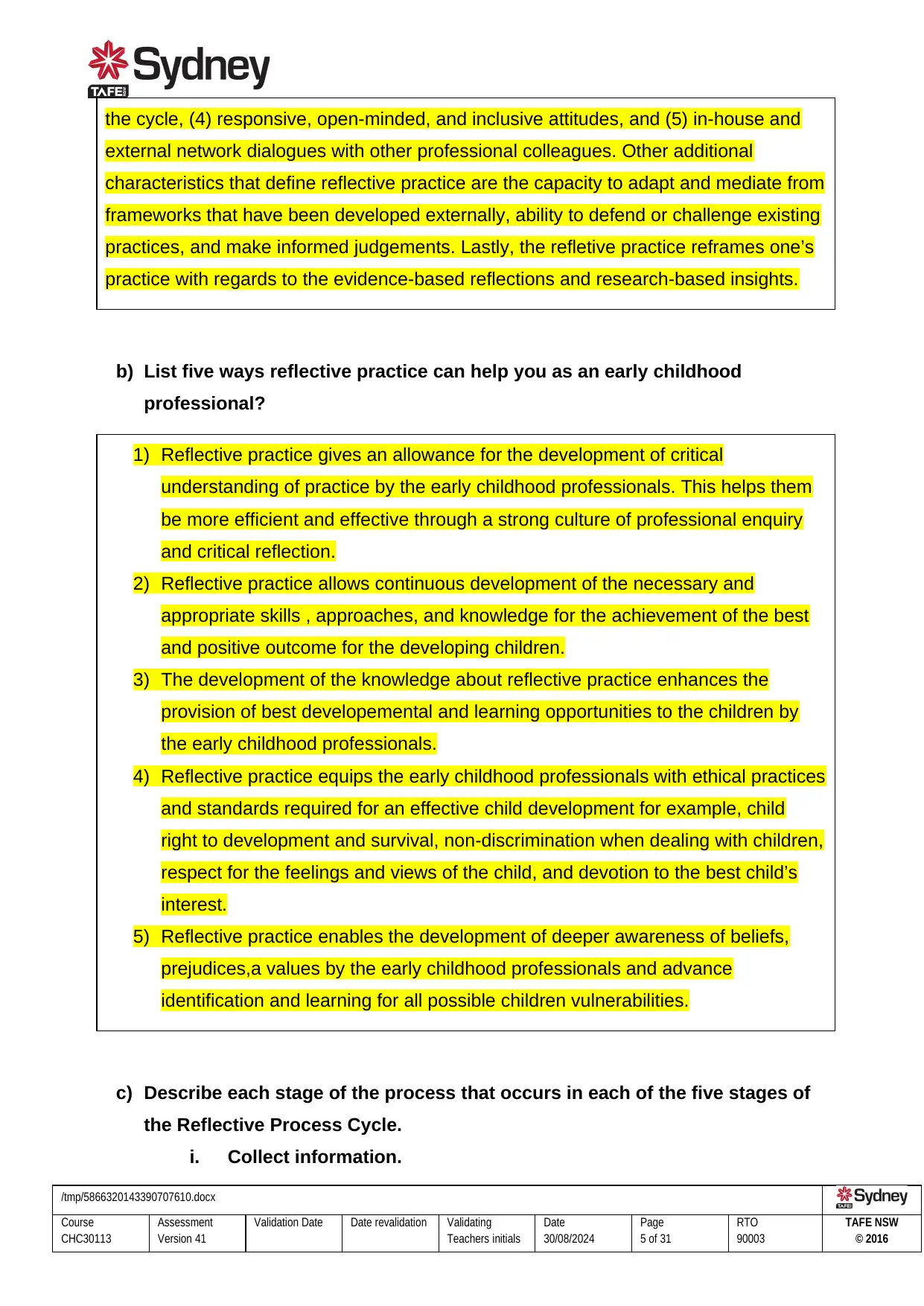
the cycle, (4) responsive, open-minded, and inclusive attitudes, and (5) in-house and
external network dialogues with other professional colleagues. Other additional
characteristics that define reflective practice are the capacity to adapt and mediate from
frameworks that have been developed externally, ability to defend or challenge existing
practices, and make informed judgements. Lastly, the refletive practice reframes one’s
practice with regards to the evidence-based reflections and research-based insights.
b) List five ways reflective practice can help you as an early childhood
professional?
1) Reflective practice gives an allowance for the development of critical
understanding of practice by the early childhood professionals. This helps them
be more efficient and effective through a strong culture of professional enquiry
and critical reflection.
2) Reflective practice allows continuous development of the necessary and
appropriate skills , approaches, and knowledge for the achievement of the best
and positive outcome for the developing children.
3) The development of the knowledge about reflective practice enhances the
provision of best developemental and learning opportunities to the children by
the early childhood professionals.
4) Reflective practice equips the early childhood professionals with ethical practices
and standards required for an effective child development for example, child
right to development and survival, non-discrimination when dealing with children,
respect for the feelings and views of the child, and devotion to the best child’s
interest.
5) Reflective practice enables the development of deeper awareness of beliefs,
prejudices,a values by the early childhood professionals and advance
identification and learning for all possible children vulnerabilities.
c) Describe each stage of the process that occurs in each of the five stages of
the Reflective Process Cycle.
i. Collect information.
/tmp/5866320143390707610.docx
Course
CHC30113
Assessment
Version 41
Validation Date Date revalidation Validating
Teachers initials
Date
30/08/2024
Page
5 of 31
RTO
90003
TAFE NSW
© 2016
external network dialogues with other professional colleagues. Other additional
characteristics that define reflective practice are the capacity to adapt and mediate from
frameworks that have been developed externally, ability to defend or challenge existing
practices, and make informed judgements. Lastly, the refletive practice reframes one’s
practice with regards to the evidence-based reflections and research-based insights.
b) List five ways reflective practice can help you as an early childhood
professional?
1) Reflective practice gives an allowance for the development of critical
understanding of practice by the early childhood professionals. This helps them
be more efficient and effective through a strong culture of professional enquiry
and critical reflection.
2) Reflective practice allows continuous development of the necessary and
appropriate skills , approaches, and knowledge for the achievement of the best
and positive outcome for the developing children.
3) The development of the knowledge about reflective practice enhances the
provision of best developemental and learning opportunities to the children by
the early childhood professionals.
4) Reflective practice equips the early childhood professionals with ethical practices
and standards required for an effective child development for example, child
right to development and survival, non-discrimination when dealing with children,
respect for the feelings and views of the child, and devotion to the best child’s
interest.
5) Reflective practice enables the development of deeper awareness of beliefs,
prejudices,a values by the early childhood professionals and advance
identification and learning for all possible children vulnerabilities.
c) Describe each stage of the process that occurs in each of the five stages of
the Reflective Process Cycle.
i. Collect information.
/tmp/5866320143390707610.docx
Course
CHC30113
Assessment
Version 41
Validation Date Date revalidation Validating
Teachers initials
Date
30/08/2024
Page
5 of 31
RTO
90003
TAFE NSW
© 2016
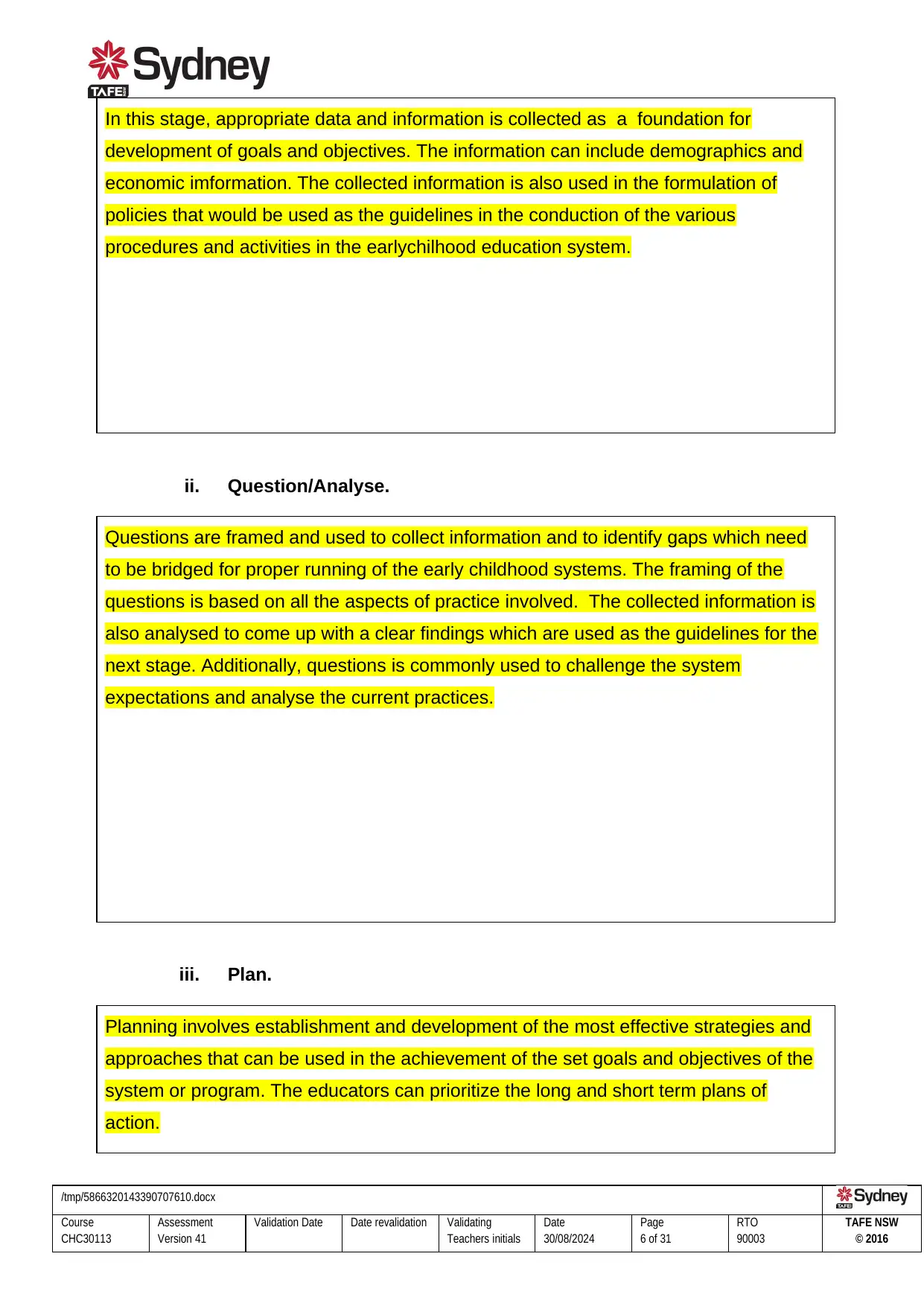
In this stage, appropriate data and information is collected as a foundation for
development of goals and objectives. The information can include demographics and
economic imformation. The collected information is also used in the formulation of
policies that would be used as the guidelines in the conduction of the various
procedures and activities in the earlychilhood education system.
ii. Question/Analyse.
Questions are framed and used to collect information and to identify gaps which need
to be bridged for proper running of the early childhood systems. The framing of the
questions is based on all the aspects of practice involved. The collected information is
also analysed to come up with a clear findings which are used as the guidelines for the
next stage. Additionally, questions is commonly used to challenge the system
expectations and analyse the current practices.
iii. Plan.
Planning involves establishment and development of the most effective strategies and
approaches that can be used in the achievement of the set goals and objectives of the
system or program. The educators can prioritize the long and short term plans of
action.
/tmp/5866320143390707610.docx
Course
CHC30113
Assessment
Version 41
Validation Date Date revalidation Validating
Teachers initials
Date
30/08/2024
Page
6 of 31
RTO
90003
TAFE NSW
© 2016
development of goals and objectives. The information can include demographics and
economic imformation. The collected information is also used in the formulation of
policies that would be used as the guidelines in the conduction of the various
procedures and activities in the earlychilhood education system.
ii. Question/Analyse.
Questions are framed and used to collect information and to identify gaps which need
to be bridged for proper running of the early childhood systems. The framing of the
questions is based on all the aspects of practice involved. The collected information is
also analysed to come up with a clear findings which are used as the guidelines for the
next stage. Additionally, questions is commonly used to challenge the system
expectations and analyse the current practices.
iii. Plan.
Planning involves establishment and development of the most effective strategies and
approaches that can be used in the achievement of the set goals and objectives of the
system or program. The educators can prioritize the long and short term plans of
action.
/tmp/5866320143390707610.docx
Course
CHC30113
Assessment
Version 41
Validation Date Date revalidation Validating
Teachers initials
Date
30/08/2024
Page
6 of 31
RTO
90003
TAFE NSW
© 2016
⊘ This is a preview!⊘
Do you want full access?
Subscribe today to unlock all pages.

Trusted by 1+ million students worldwide
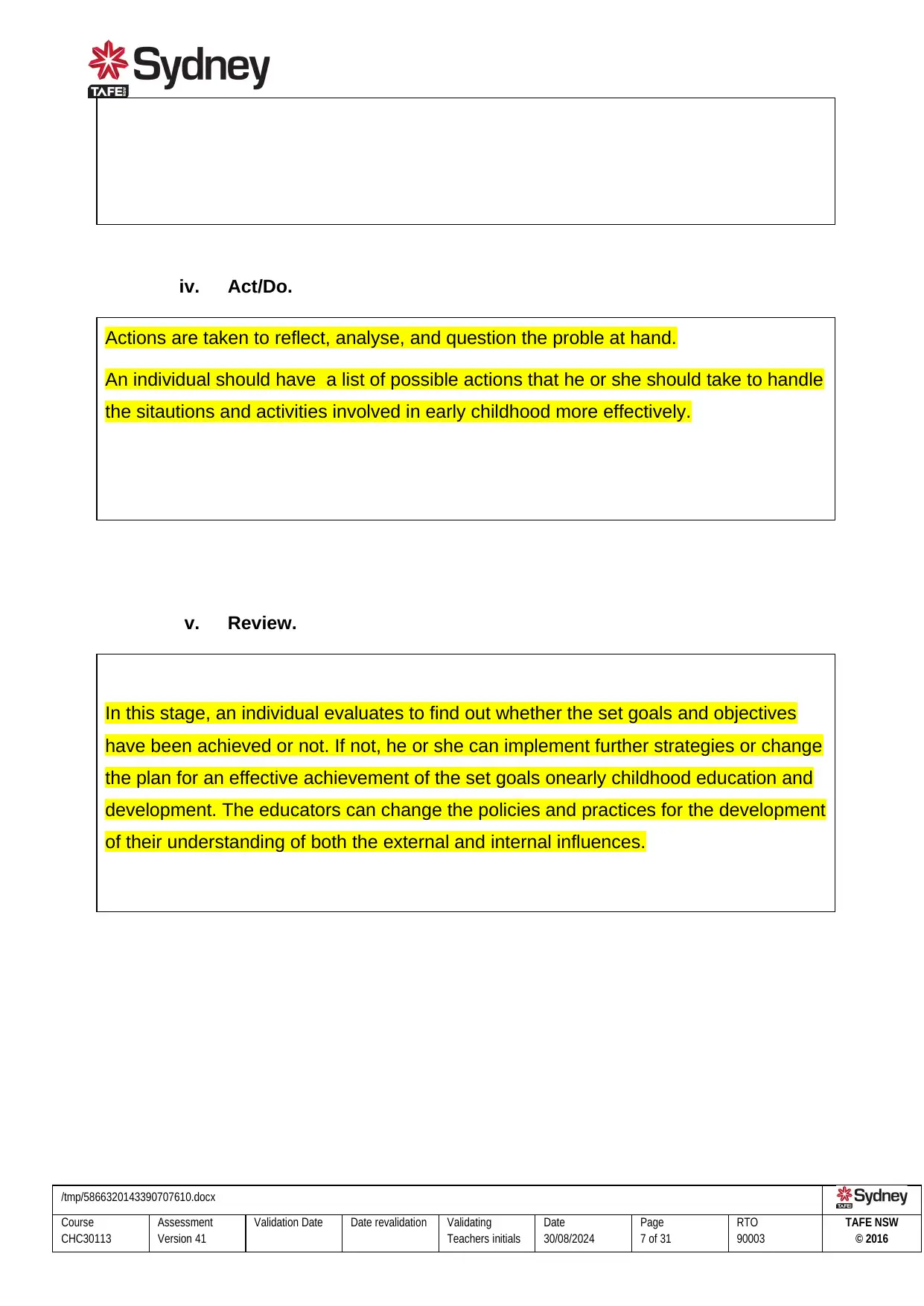
iv. Act/Do.
Actions are taken to reflect, analyse, and question the proble at hand.
An individual should have a list of possible actions that he or she should take to handle
the sitautions and activities involved in early childhood more effectively.
v. Review.
In this stage, an individual evaluates to find out whether the set goals and objectives
have been achieved or not. If not, he or she can implement further strategies or change
the plan for an effective achievement of the set goals onearly childhood education and
development. The educators can change the policies and practices for the development
of their understanding of both the external and internal influences.
/tmp/5866320143390707610.docx
Course
CHC30113
Assessment
Version 41
Validation Date Date revalidation Validating
Teachers initials
Date
30/08/2024
Page
7 of 31
RTO
90003
TAFE NSW
© 2016
Actions are taken to reflect, analyse, and question the proble at hand.
An individual should have a list of possible actions that he or she should take to handle
the sitautions and activities involved in early childhood more effectively.
v. Review.
In this stage, an individual evaluates to find out whether the set goals and objectives
have been achieved or not. If not, he or she can implement further strategies or change
the plan for an effective achievement of the set goals onearly childhood education and
development. The educators can change the policies and practices for the development
of their understanding of both the external and internal influences.
/tmp/5866320143390707610.docx
Course
CHC30113
Assessment
Version 41
Validation Date Date revalidation Validating
Teachers initials
Date
30/08/2024
Page
7 of 31
RTO
90003
TAFE NSW
© 2016
Paraphrase This Document
Need a fresh take? Get an instant paraphrase of this document with our AI Paraphraser
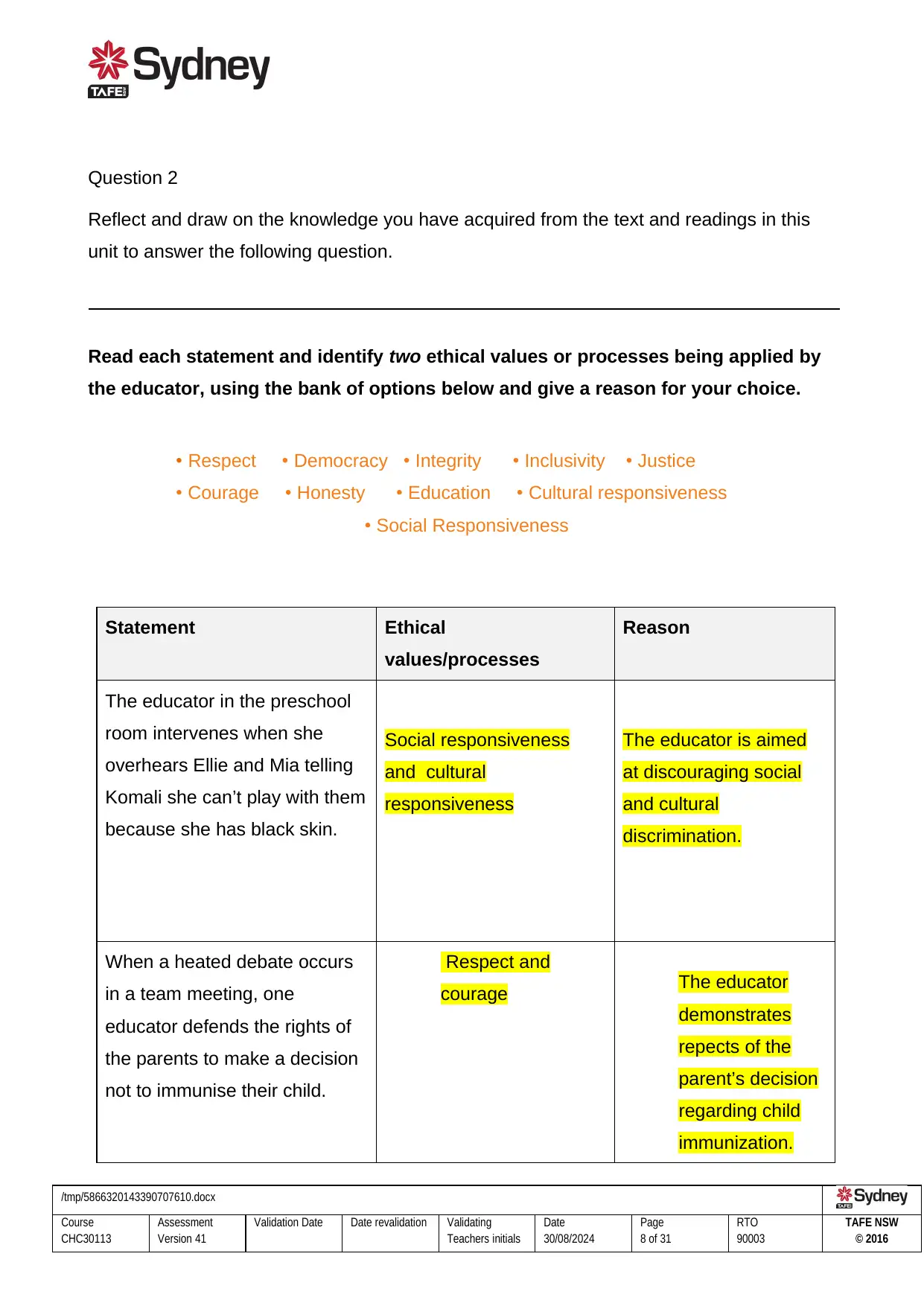
Question 2
Reflect and draw on the knowledge you have acquired from the text and readings in this
unit to answer the following question.
Read each statement and identify two ethical values or processes being applied by
the educator, using the bank of options below and give a reason for your choice.
Respect Democracy Integrity Inclusivity Justice
Courage Honesty Education Cultural responsiveness
Social Responsiveness
Statement Ethical
values/processes
Reason
The educator in the preschool
room intervenes when she
overhears Ellie and Mia telling
Komali she can’t play with them
because she has black skin.
Social responsiveness
and cultural
responsiveness
The educator is aimed
at discouraging social
and cultural
discrimination.
When a heated debate occurs
in a team meeting, one
educator defends the rights of
the parents to make a decision
not to immunise their child.
Respect and
courage The educator
demonstrates
repects of the
parent’s decision
regarding child
immunization.
/tmp/5866320143390707610.docx
Course
CHC30113
Assessment
Version 41
Validation Date Date revalidation Validating
Teachers initials
Date
30/08/2024
Page
8 of 31
RTO
90003
TAFE NSW
© 2016
Reflect and draw on the knowledge you have acquired from the text and readings in this
unit to answer the following question.
Read each statement and identify two ethical values or processes being applied by
the educator, using the bank of options below and give a reason for your choice.
Respect Democracy Integrity Inclusivity Justice
Courage Honesty Education Cultural responsiveness
Social Responsiveness
Statement Ethical
values/processes
Reason
The educator in the preschool
room intervenes when she
overhears Ellie and Mia telling
Komali she can’t play with them
because she has black skin.
Social responsiveness
and cultural
responsiveness
The educator is aimed
at discouraging social
and cultural
discrimination.
When a heated debate occurs
in a team meeting, one
educator defends the rights of
the parents to make a decision
not to immunise their child.
Respect and
courage The educator
demonstrates
repects of the
parent’s decision
regarding child
immunization.
/tmp/5866320143390707610.docx
Course
CHC30113
Assessment
Version 41
Validation Date Date revalidation Validating
Teachers initials
Date
30/08/2024
Page
8 of 31
RTO
90003
TAFE NSW
© 2016
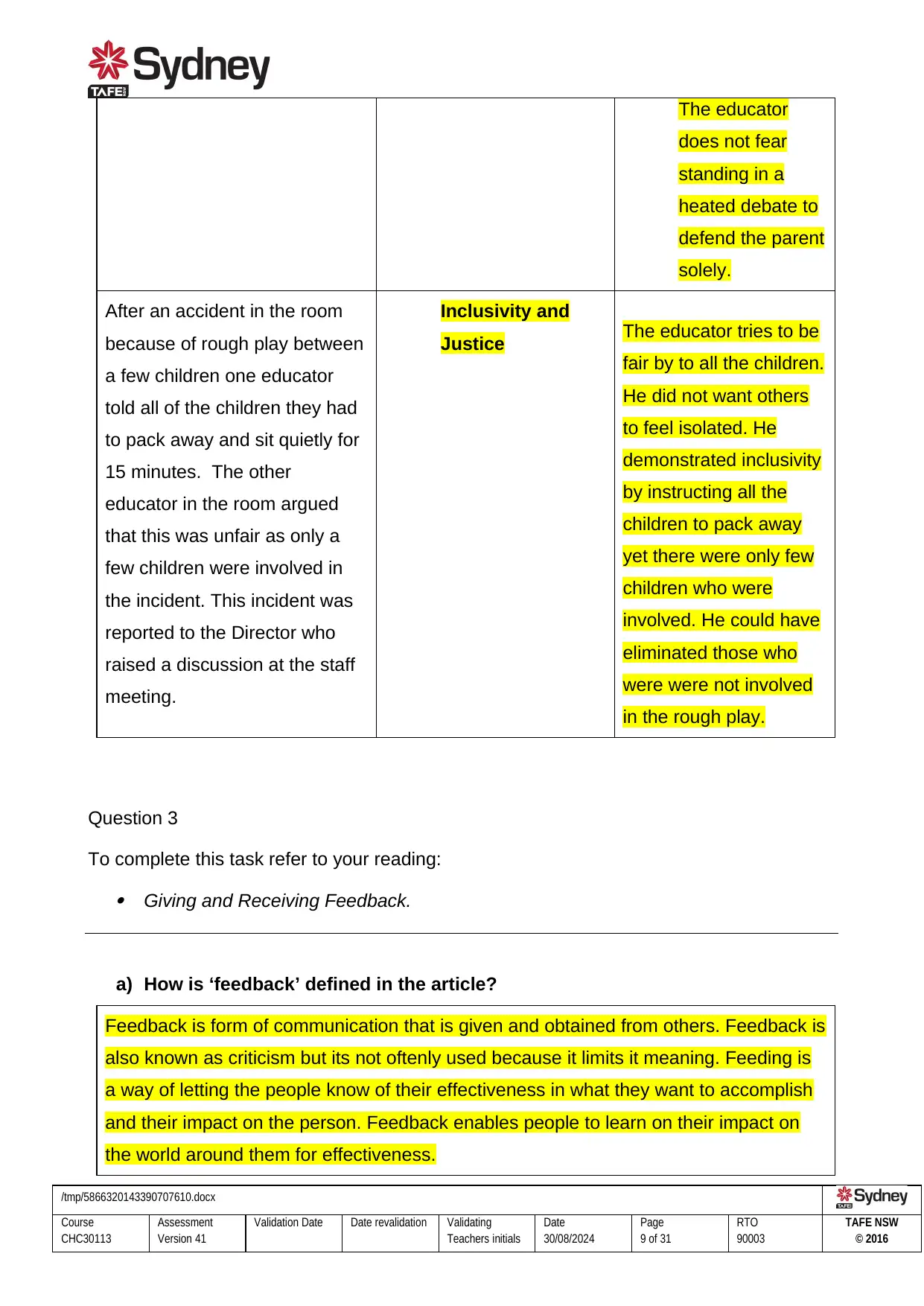
The educator
does not fear
standing in a
heated debate to
defend the parent
solely.
After an accident in the room
because of rough play between
a few children one educator
told all of the children they had
to pack away and sit quietly for
15 minutes. The other
educator in the room argued
that this was unfair as only a
few children were involved in
the incident. This incident was
reported to the Director who
raised a discussion at the staff
meeting.
Inclusivity and
Justice The educator tries to be
fair by to all the children.
He did not want others
to feel isolated. He
demonstrated inclusivity
by instructing all the
children to pack away
yet there were only few
children who were
involved. He could have
eliminated those who
were were not involved
in the rough play.
Question 3
To complete this task refer to your reading:
Giving and Receiving Feedback.
a) How is ‘feedback’ defined in the article?
Feedback is form of communication that is given and obtained from others. Feedback is
also known as criticism but its not oftenly used because it limits it meaning. Feeding is
a way of letting the people know of their effectiveness in what they want to accomplish
and their impact on the person. Feedback enables people to learn on their impact on
the world around them for effectiveness.
/tmp/5866320143390707610.docx
Course
CHC30113
Assessment
Version 41
Validation Date Date revalidation Validating
Teachers initials
Date
30/08/2024
Page
9 of 31
RTO
90003
TAFE NSW
© 2016
does not fear
standing in a
heated debate to
defend the parent
solely.
After an accident in the room
because of rough play between
a few children one educator
told all of the children they had
to pack away and sit quietly for
15 minutes. The other
educator in the room argued
that this was unfair as only a
few children were involved in
the incident. This incident was
reported to the Director who
raised a discussion at the staff
meeting.
Inclusivity and
Justice The educator tries to be
fair by to all the children.
He did not want others
to feel isolated. He
demonstrated inclusivity
by instructing all the
children to pack away
yet there were only few
children who were
involved. He could have
eliminated those who
were were not involved
in the rough play.
Question 3
To complete this task refer to your reading:
Giving and Receiving Feedback.
a) How is ‘feedback’ defined in the article?
Feedback is form of communication that is given and obtained from others. Feedback is
also known as criticism but its not oftenly used because it limits it meaning. Feeding is
a way of letting the people know of their effectiveness in what they want to accomplish
and their impact on the person. Feedback enables people to learn on their impact on
the world around them for effectiveness.
/tmp/5866320143390707610.docx
Course
CHC30113
Assessment
Version 41
Validation Date Date revalidation Validating
Teachers initials
Date
30/08/2024
Page
9 of 31
RTO
90003
TAFE NSW
© 2016
⊘ This is a preview!⊘
Do you want full access?
Subscribe today to unlock all pages.

Trusted by 1+ million students worldwide
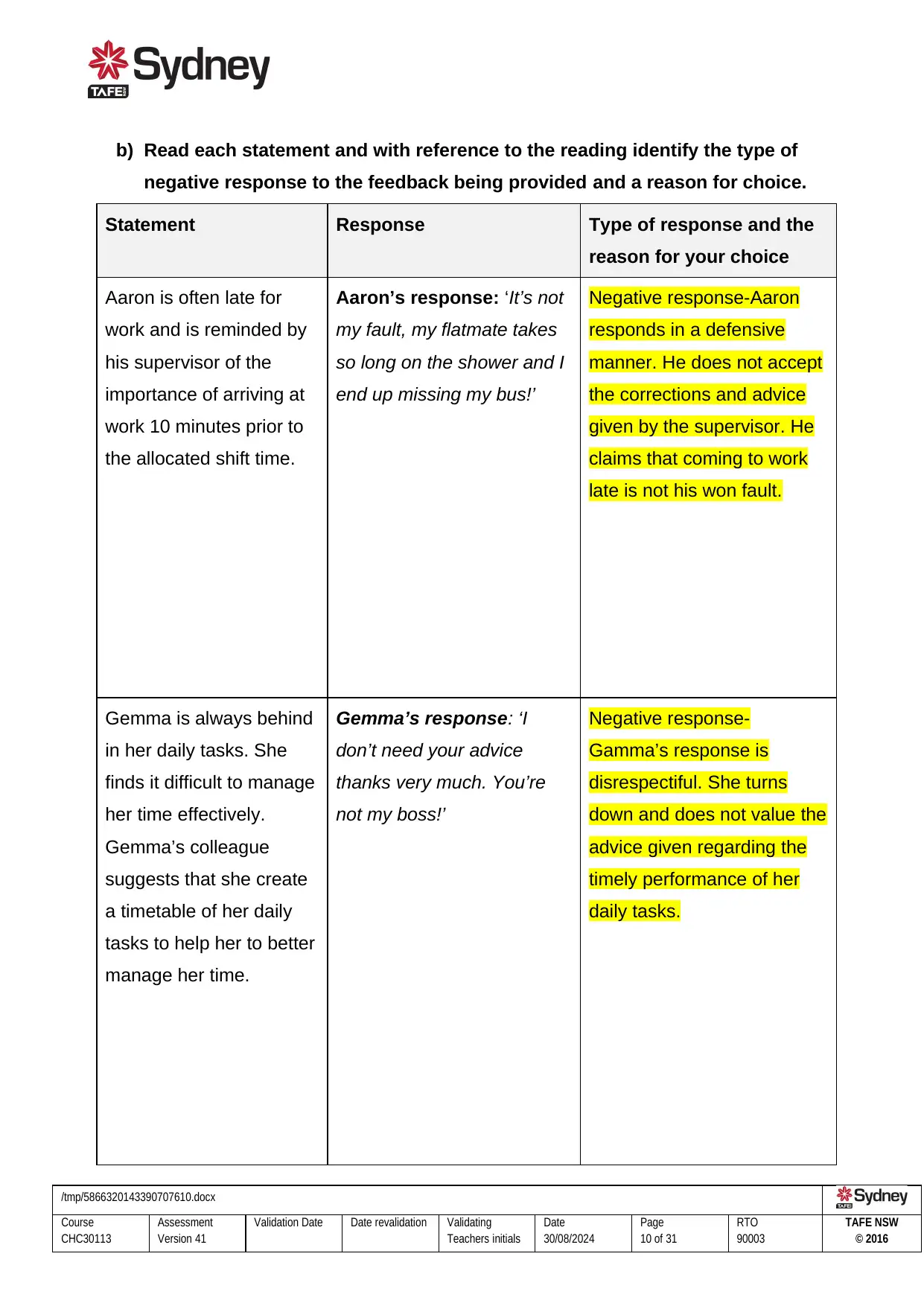
b) Read each statement and with reference to the reading identify the type of
negative response to the feedback being provided and a reason for choice.
Statement Response Type of response and the
reason for your choice
Aaron is often late for
work and is reminded by
his supervisor of the
importance of arriving at
work 10 minutes prior to
the allocated shift time.
Aaron’s response: ‘It’s not
my fault, my flatmate takes
so long on the shower and I
end up missing my bus!’
Negative response-Aaron
responds in a defensive
manner. He does not accept
the corrections and advice
given by the supervisor. He
claims that coming to work
late is not his won fault.
Gemma is always behind
in her daily tasks. She
finds it difficult to manage
her time effectively.
Gemma’s colleague
suggests that she create
a timetable of her daily
tasks to help her to better
manage her time.
Gemma’s response: ‘I
don’t need your advice
thanks very much. You’re
not my boss!’
Negative response-
Gamma’s response is
disrespectiful. She turns
down and does not value the
advice given regarding the
timely performance of her
daily tasks.
/tmp/5866320143390707610.docx
Course
CHC30113
Assessment
Version 41
Validation Date Date revalidation Validating
Teachers initials
Date
30/08/2024
Page
10 of 31
RTO
90003
TAFE NSW
© 2016
negative response to the feedback being provided and a reason for choice.
Statement Response Type of response and the
reason for your choice
Aaron is often late for
work and is reminded by
his supervisor of the
importance of arriving at
work 10 minutes prior to
the allocated shift time.
Aaron’s response: ‘It’s not
my fault, my flatmate takes
so long on the shower and I
end up missing my bus!’
Negative response-Aaron
responds in a defensive
manner. He does not accept
the corrections and advice
given by the supervisor. He
claims that coming to work
late is not his won fault.
Gemma is always behind
in her daily tasks. She
finds it difficult to manage
her time effectively.
Gemma’s colleague
suggests that she create
a timetable of her daily
tasks to help her to better
manage her time.
Gemma’s response: ‘I
don’t need your advice
thanks very much. You’re
not my boss!’
Negative response-
Gamma’s response is
disrespectiful. She turns
down and does not value the
advice given regarding the
timely performance of her
daily tasks.
/tmp/5866320143390707610.docx
Course
CHC30113
Assessment
Version 41
Validation Date Date revalidation Validating
Teachers initials
Date
30/08/2024
Page
10 of 31
RTO
90003
TAFE NSW
© 2016
Paraphrase This Document
Need a fresh take? Get an instant paraphrase of this document with our AI Paraphraser
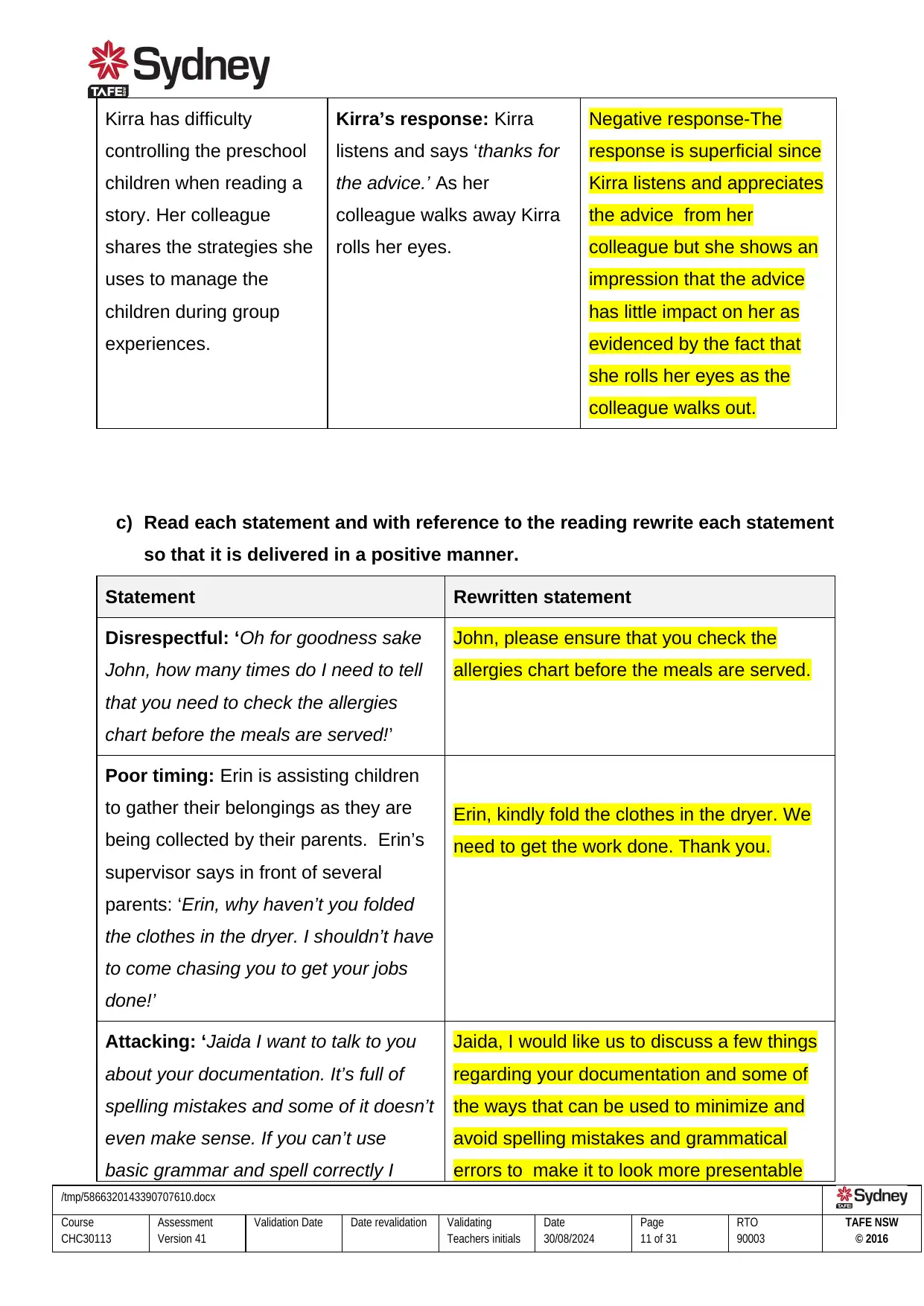
Kirra has difficulty
controlling the preschool
children when reading a
story. Her colleague
shares the strategies she
uses to manage the
children during group
experiences.
Kirra’s response: Kirra
listens and says ‘thanks for
the advice.’ As her
colleague walks away Kirra
rolls her eyes.
Negative response-The
response is superficial since
Kirra listens and appreciates
the advice from her
colleague but she shows an
impression that the advice
has little impact on her as
evidenced by the fact that
she rolls her eyes as the
colleague walks out.
c) Read each statement and with reference to the reading rewrite each statement
so that it is delivered in a positive manner.
Statement Rewritten statement
Disrespectful: ‘Oh for goodness sake
John, how many times do I need to tell
that you need to check the allergies
chart before the meals are served!’
John, please ensure that you check the
allergies chart before the meals are served.
Poor timing: Erin is assisting children
to gather their belongings as they are
being collected by their parents. Erin’s
supervisor says in front of several
parents: ‘Erin, why haven’t you folded
the clothes in the dryer. I shouldn’t have
to come chasing you to get your jobs
done!’
Erin, kindly fold the clothes in the dryer. We
need to get the work done. Thank you.
Attacking: ‘Jaida I want to talk to you
about your documentation. It’s full of
spelling mistakes and some of it doesn’t
even make sense. If you can’t use
basic grammar and spell correctly I
Jaida, I would like us to discuss a few things
regarding your documentation and some of
the ways that can be used to minimize and
avoid spelling mistakes and grammatical
errors to make it to look more presentable
/tmp/5866320143390707610.docx
Course
CHC30113
Assessment
Version 41
Validation Date Date revalidation Validating
Teachers initials
Date
30/08/2024
Page
11 of 31
RTO
90003
TAFE NSW
© 2016
controlling the preschool
children when reading a
story. Her colleague
shares the strategies she
uses to manage the
children during group
experiences.
Kirra’s response: Kirra
listens and says ‘thanks for
the advice.’ As her
colleague walks away Kirra
rolls her eyes.
Negative response-The
response is superficial since
Kirra listens and appreciates
the advice from her
colleague but she shows an
impression that the advice
has little impact on her as
evidenced by the fact that
she rolls her eyes as the
colleague walks out.
c) Read each statement and with reference to the reading rewrite each statement
so that it is delivered in a positive manner.
Statement Rewritten statement
Disrespectful: ‘Oh for goodness sake
John, how many times do I need to tell
that you need to check the allergies
chart before the meals are served!’
John, please ensure that you check the
allergies chart before the meals are served.
Poor timing: Erin is assisting children
to gather their belongings as they are
being collected by their parents. Erin’s
supervisor says in front of several
parents: ‘Erin, why haven’t you folded
the clothes in the dryer. I shouldn’t have
to come chasing you to get your jobs
done!’
Erin, kindly fold the clothes in the dryer. We
need to get the work done. Thank you.
Attacking: ‘Jaida I want to talk to you
about your documentation. It’s full of
spelling mistakes and some of it doesn’t
even make sense. If you can’t use
basic grammar and spell correctly I
Jaida, I would like us to discuss a few things
regarding your documentation and some of
the ways that can be used to minimize and
avoid spelling mistakes and grammatical
errors to make it to look more presentable
/tmp/5866320143390707610.docx
Course
CHC30113
Assessment
Version 41
Validation Date Date revalidation Validating
Teachers initials
Date
30/08/2024
Page
11 of 31
RTO
90003
TAFE NSW
© 2016
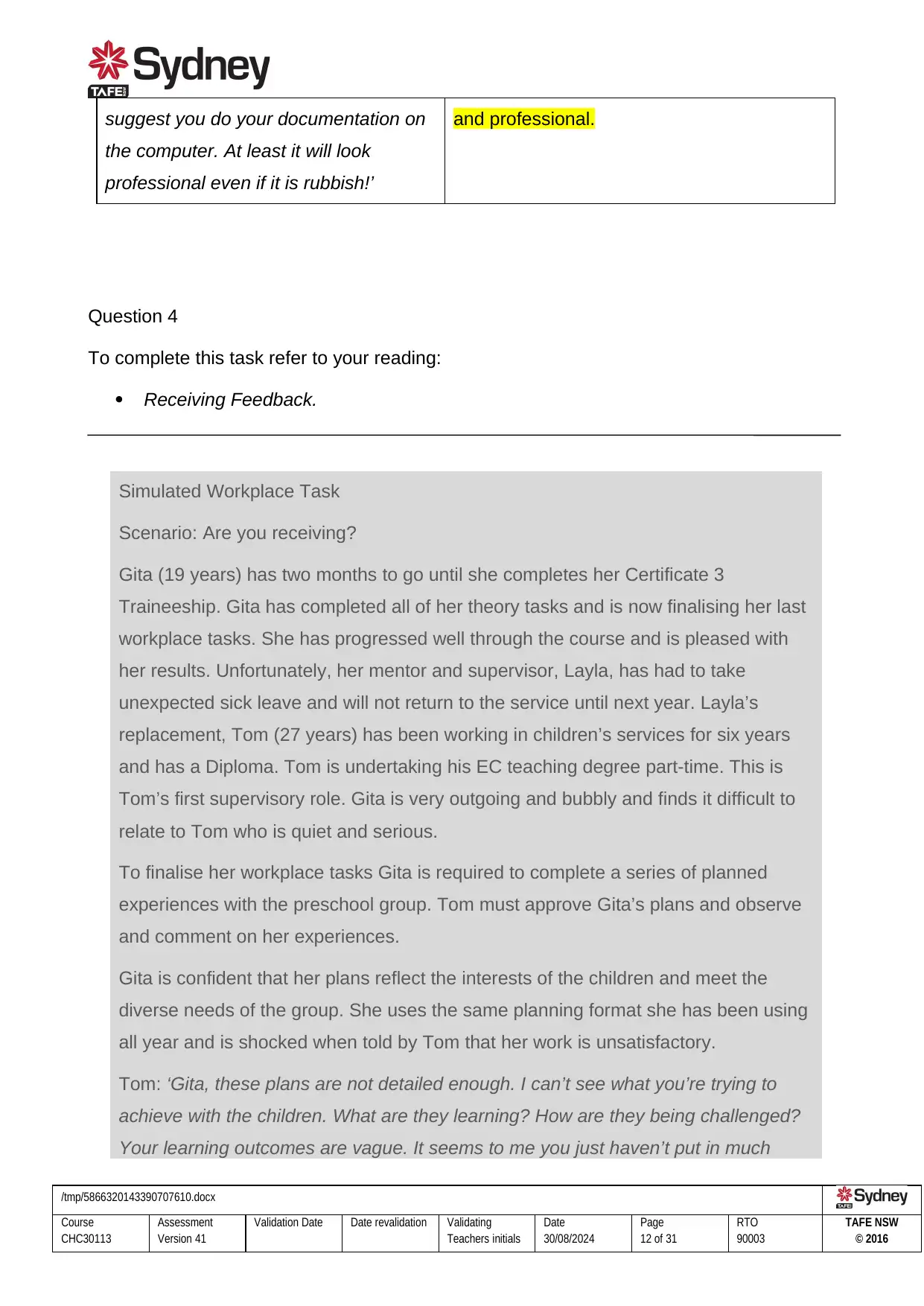
suggest you do your documentation on
the computer. At least it will look
professional even if it is rubbish!’
and professional.
Question 4
To complete this task refer to your reading:
Receiving Feedback.
Simulated Workplace Task
Scenario: Are you receiving?
Gita (19 years) has two months to go until she completes her Certificate 3
Traineeship. Gita has completed all of her theory tasks and is now finalising her last
workplace tasks. She has progressed well through the course and is pleased with
her results. Unfortunately, her mentor and supervisor, Layla, has had to take
unexpected sick leave and will not return to the service until next year. Layla’s
replacement, Tom (27 years) has been working in children’s services for six years
and has a Diploma. Tom is undertaking his EC teaching degree part-time. This is
Tom’s first supervisory role. Gita is very outgoing and bubbly and finds it difficult to
relate to Tom who is quiet and serious.
To finalise her workplace tasks Gita is required to complete a series of planned
experiences with the preschool group. Tom must approve Gita’s plans and observe
and comment on her experiences.
Gita is confident that her plans reflect the interests of the children and meet the
diverse needs of the group. She uses the same planning format she has been using
all year and is shocked when told by Tom that her work is unsatisfactory.
Tom: ‘Gita, these plans are not detailed enough. I can’t see what you’re trying to
achieve with the children. What are they learning? How are they being challenged?
Your learning outcomes are vague. It seems to me you just haven’t put in much
/tmp/5866320143390707610.docx
Course
CHC30113
Assessment
Version 41
Validation Date Date revalidation Validating
Teachers initials
Date
30/08/2024
Page
12 of 31
RTO
90003
TAFE NSW
© 2016
the computer. At least it will look
professional even if it is rubbish!’
and professional.
Question 4
To complete this task refer to your reading:
Receiving Feedback.
Simulated Workplace Task
Scenario: Are you receiving?
Gita (19 years) has two months to go until she completes her Certificate 3
Traineeship. Gita has completed all of her theory tasks and is now finalising her last
workplace tasks. She has progressed well through the course and is pleased with
her results. Unfortunately, her mentor and supervisor, Layla, has had to take
unexpected sick leave and will not return to the service until next year. Layla’s
replacement, Tom (27 years) has been working in children’s services for six years
and has a Diploma. Tom is undertaking his EC teaching degree part-time. This is
Tom’s first supervisory role. Gita is very outgoing and bubbly and finds it difficult to
relate to Tom who is quiet and serious.
To finalise her workplace tasks Gita is required to complete a series of planned
experiences with the preschool group. Tom must approve Gita’s plans and observe
and comment on her experiences.
Gita is confident that her plans reflect the interests of the children and meet the
diverse needs of the group. She uses the same planning format she has been using
all year and is shocked when told by Tom that her work is unsatisfactory.
Tom: ‘Gita, these plans are not detailed enough. I can’t see what you’re trying to
achieve with the children. What are they learning? How are they being challenged?
Your learning outcomes are vague. It seems to me you just haven’t put in much
/tmp/5866320143390707610.docx
Course
CHC30113
Assessment
Version 41
Validation Date Date revalidation Validating
Teachers initials
Date
30/08/2024
Page
12 of 31
RTO
90003
TAFE NSW
© 2016
⊘ This is a preview!⊘
Do you want full access?
Subscribe today to unlock all pages.

Trusted by 1+ million students worldwide
1 out of 31
Related Documents
Your All-in-One AI-Powered Toolkit for Academic Success.
+13062052269
info@desklib.com
Available 24*7 on WhatsApp / Email
![[object Object]](/_next/static/media/star-bottom.7253800d.svg)
Unlock your academic potential
Copyright © 2020–2025 A2Z Services. All Rights Reserved. Developed and managed by ZUCOL.


